Wayfinding: Developing language for health-care sign systems
by all | 3 May 2013 8:30 am
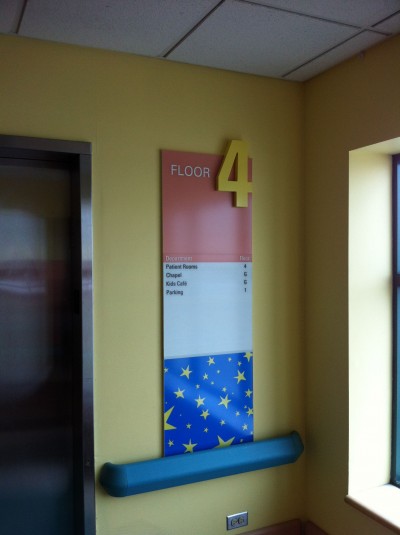 [1]
[1]Images courtesy Gnu Group
By Philip Murphy
Research indicates thousands of hours of staff time in large health-care facilities and campuses are spent answering visitors’ questions about how to find their destinations. Granted, it only takes a few seconds or minutes each time to provide the necessary directions, but having to respond to wayfinding questions consumes valuable resources, as employees are interrupting their own work routines for this purpose.
Meanwhile, the frustration of being disoriented during their health-care experience is significantly reducing patients’ level of satisfaction. In surveys of patient complaints, getting lost continually appears high on the list.
In response, many health-care organizations are devoting a lot of attention today to providing more effective orientation and wayfinding instructions. Too often, however, they assume signs alone are the solution to this problem.
While it is likely signs will always be the mainstay of any wayfinding program, simply adding more signs will not inherently solve a facility’s wayfinding problems. Instead of a greater number of signs, the objective should be to make the existing sign system more effective.
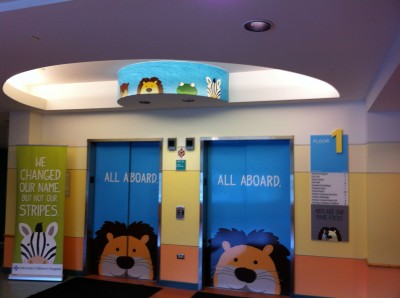 [2]
[2]Advocate Children’s Hospital in Chicago, Ill., recently commissioned a wayfinding master plan in conjunction with a new branding program.
Signs need to guide people in a logically unfolding sequence. Messages should be presented simply and clearly, such that even first-time visitors are able to immediately recognize their destination and the path to get there.
Currently, however, signs in most health-care facilities disseminate too much information and often at the wrong locations. Though based on a genuine desire to provide sufficient detail, they end up offering directions to virtually any place someone might need to go, usually too early in their journey, which only adds to confusion.
Progressive and alphanumeric
One solution to this problem of too much information on signs is progressive disclosure. This concept involves providing only the information needed to move a visitor from one decision point to the next.
This method is already used very effectively in most airports, for example, where passengers are guided in increments—first to the correct parking lot, then to the terminal building, then to the departures concourse and ultimately to the flight gate.
In an airport, passengers know their destination by way of their airline’s name, flight number and gate number and can follow highly visible cues. In a health-care environment, however, even when patients know a physician’s name and/or department, there tends to be little or nothing intuitive about the path to their destination. This is because health-care facilities are not organized linearly like airports are. For this reason, progressive disclosure in a hospital presents unique planning challenges.
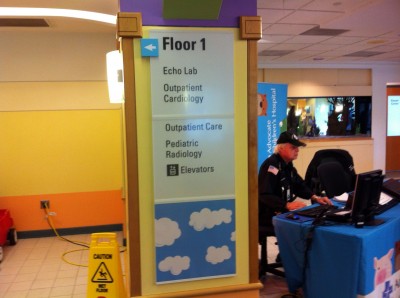 [3]
[3]An effective sign system can help prevent hospital staff from having to spend thousands of hours each year answering visitors’ questions.
There are also challenges with regard to choosing the most appropriate wayfinding language. Indeed, a common pitfall for health-care wayfinding programs is the failure to communicate with patients in terms they can easily understand.
Traditionally, the naming of various health-care departments, facilities and other destinations has relied on medical terminology, including designations for specific practice areas and specialties. Unfortunately, this naming process comprises terms that are arcane and unfamiliar—and sometimes even frightening—to the first-time hospital visitor. Most people do not know ophthalmology, for instance, refers to eye care.
Better wayfinding demands a different, simpler approach to health-care language. Primary destinations should be labelled alphanumerically. This way, if visitors arrive pre-informed of their key starting points (e.g. parking lot or main building), they can simply follow a series of signs. At each point closer to their destination, additional alphanumeric listings are provided (e.g. elevator, floor and room designations) with reference to the department or office they seek.
Alphanumeric naming and progressive disclosure can simplify communications significantly. Since both practices require fewer instructions to be viewed and remembered by the visitor, signs end up with more space for larger type, which in turn means greater legibility for visitors, patients and staff alike.
The challenge of this approach, however, is first making sure patients receive the orientation details for an upcoming appointment, including a clear name of their destination, before they actually need to arrive on-site. This is important because—unlike airports with relatively obvious paths and destinations—hospitals and other large-scale health-care facilities are generally ‘blind labyrinths’ with no architectural clues to the correct path. Signs are crucial, but knowing the wayfinding system’s language first is also crucial.
So, to ensure people understand where they are going, information needs to be communicated to them in advance of their visit. There are many possible tools for this purpose, including appointment reminders, brochures, websites, mobile wayfinding apps and phone call reminders. It is essential for all of these communications tools, as well as the facility’s signs, to share a common wayfinding language.
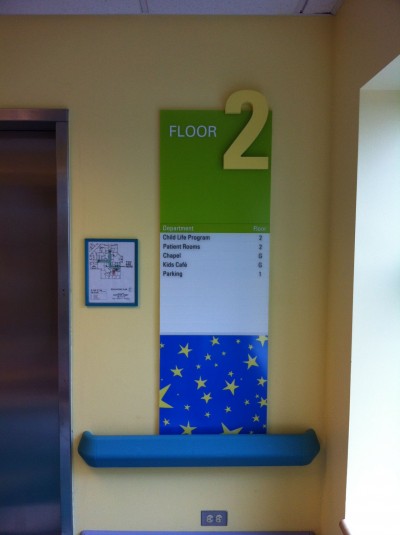 [4]
[4]Signs should provide only enough information to move a visitor from one decision point to the next.
Advocating clarity
This concept of using comprehensive wayfinding instructions to orient patients well in advance of their visit has already proven highly effective. It offers an opportunity to share the facility’s wayfinding language while also directly informing a patient how to get to an appointment.
One successful example is Advocate Children’s Hospital in Chicago, Ill., which recently commissioned a wayfinding master plan (WMP) to enhance facility navigation for its customers, in conjunction with a new branding program. The recommended WMP included a wide variety of communications tools for patients, visitors and staff.
The foundation of the program was predicated on providing simple step-by-step directions that correspond to Advocate’s organizational structure and the naming of its facilities. Prior to an appointment, tools for informing patients about how to get to their destination would include:
- a simple, printed wayfinding brochure for Advocate Children’s Hospital with a map showing each building’s name and location.
- a standard-format appointment card, digitally customized with more specific step-to-step instructions based on the exact appointment location.
- an appointment e-mail, providing instructions in clear wayfinding language.
- an optional appointment text message, delivering the same step-by-step instructions, but in a more simplified format.
Further, while at home or at work before their appointment, patients could visit the hospital’s website, where a wayfinding menu would list departments and their corresponding directions. It was also important to train—using a simple, web-based program—the hospital’s call-in staff to use consistent ‘appointment scripting’ when providing directions to visitors over the phone.
The WMP also recommended a wayfinding mobile app, whereby patients could refer to relevant information as they moved along their path, including details about specific parking zones, buildings and departments. Signs along their route, meanwhile, would use the same wayfinding language throughout the system, in roughly the following order:
- off-site directional traffic signs.
- building identification (ID) branding.
- campus markers.
- on-site directional traffic signs.
- directional parking signs.
- parking area ‘flags.’
- outpatient entrance markers.
- primary indoor directional signs.
- outpatient lobbies.
- departmental directories.
- elevator directories.
- secondary indoor directional signs.
- department ‘flags.’
- department and room ID signs.
Making it work
Any comprehensive WMP and sign program based on alphanumeric language and simple graphics must also engage all personnel within the health-care facility. While solving wayfinding problems is typically the responsibility of the facility manager, success in changing the way an organization addresses wayfinding will depend on involving a broad group of stakeholders. Executives, staff, information technology (IT) specialists and brand managers will all need to understand the program and ‘buy in.’
Once everyone is on the same page, wayfinding can be implemented in such a way that it enhances the visitor’s experience and prevents the many headaches that in the past were common when trying to get people to their destinations on time.
After all, even with the most comprehensive wayfinding plan in place, there will still be visitors asking for directions. To maximize success, therefore, all personnel throughout the facility must understand its wayfinding system and be able to give directions that are consistent with its established language.
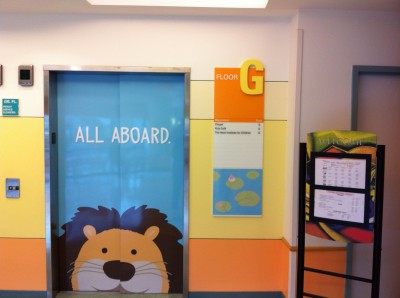 [5]
[5]Signs along a route should use the same wayfinding language for the sake of clarity and consistency.
 [6]
[6]Philip Murphy is president and CEO of the Gnu Group, an environmental graphic design (EGD) firm that has provided wayfinding systems for health-care environments for more than 40 years. For more information, visit www.gnugroup.com[7].
- [Image]: http://www.signmedia.ca/wp-content/uploads/2014/02/70.jpg
- [Image]: http://www.signmedia.ca/wp-content/uploads/2014/02/36.jpg
- [Image]: http://www.signmedia.ca/wp-content/uploads/2014/02/91.jpg
- [Image]: http://www.signmedia.ca/wp-content/uploads/2014/02/16.jpg
- [Image]: http://www.signmedia.ca/wp-content/uploads/2014/02/9.jpg
- [Image]: http://www.signmedia.ca/wp-content/uploads/2014/02/57.jpg
- www.gnugroup.com: http://www.gnugroup.com
Source URL: https://www.signmedia.ca/developing-language-for-health-care-sign-systems/